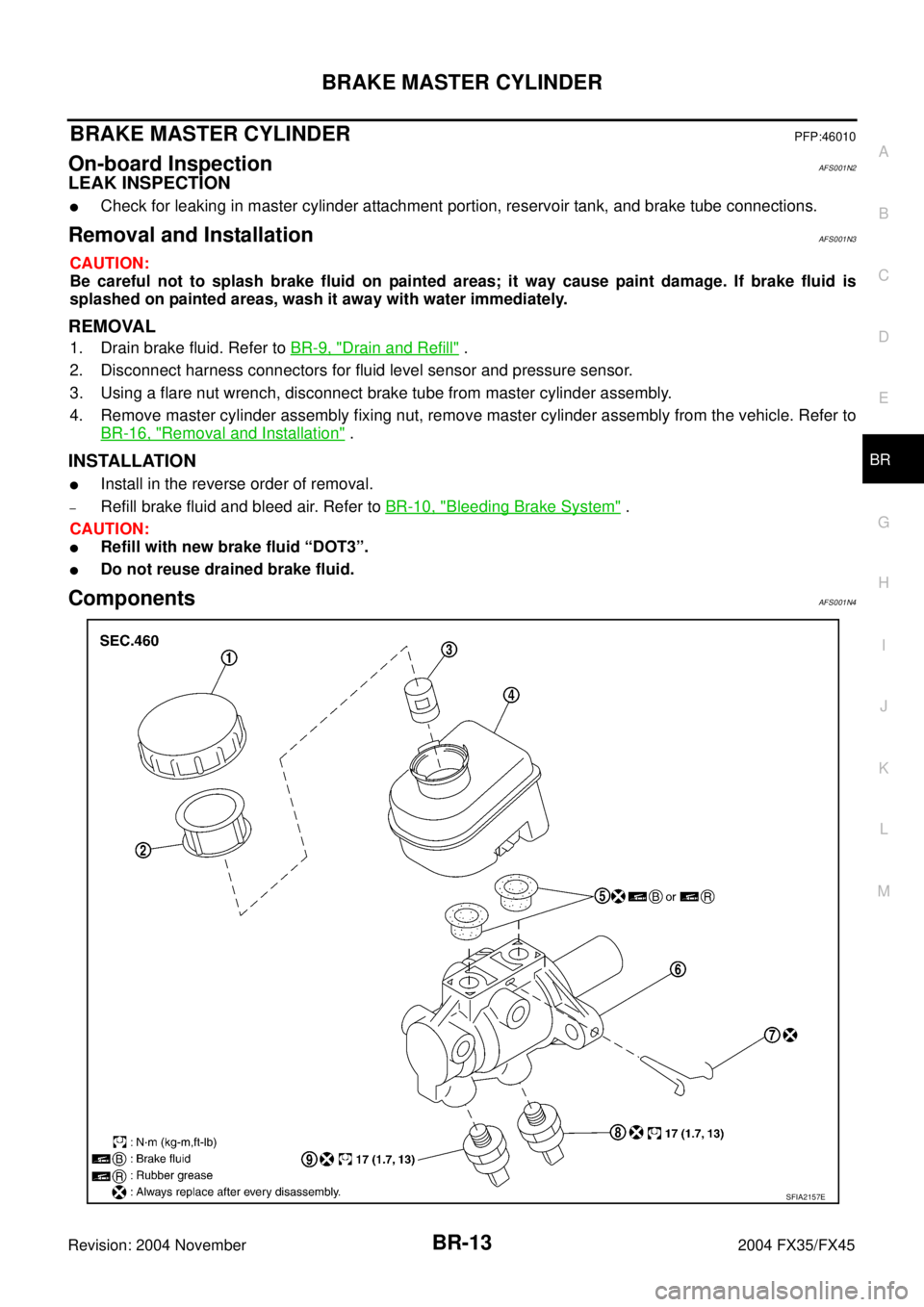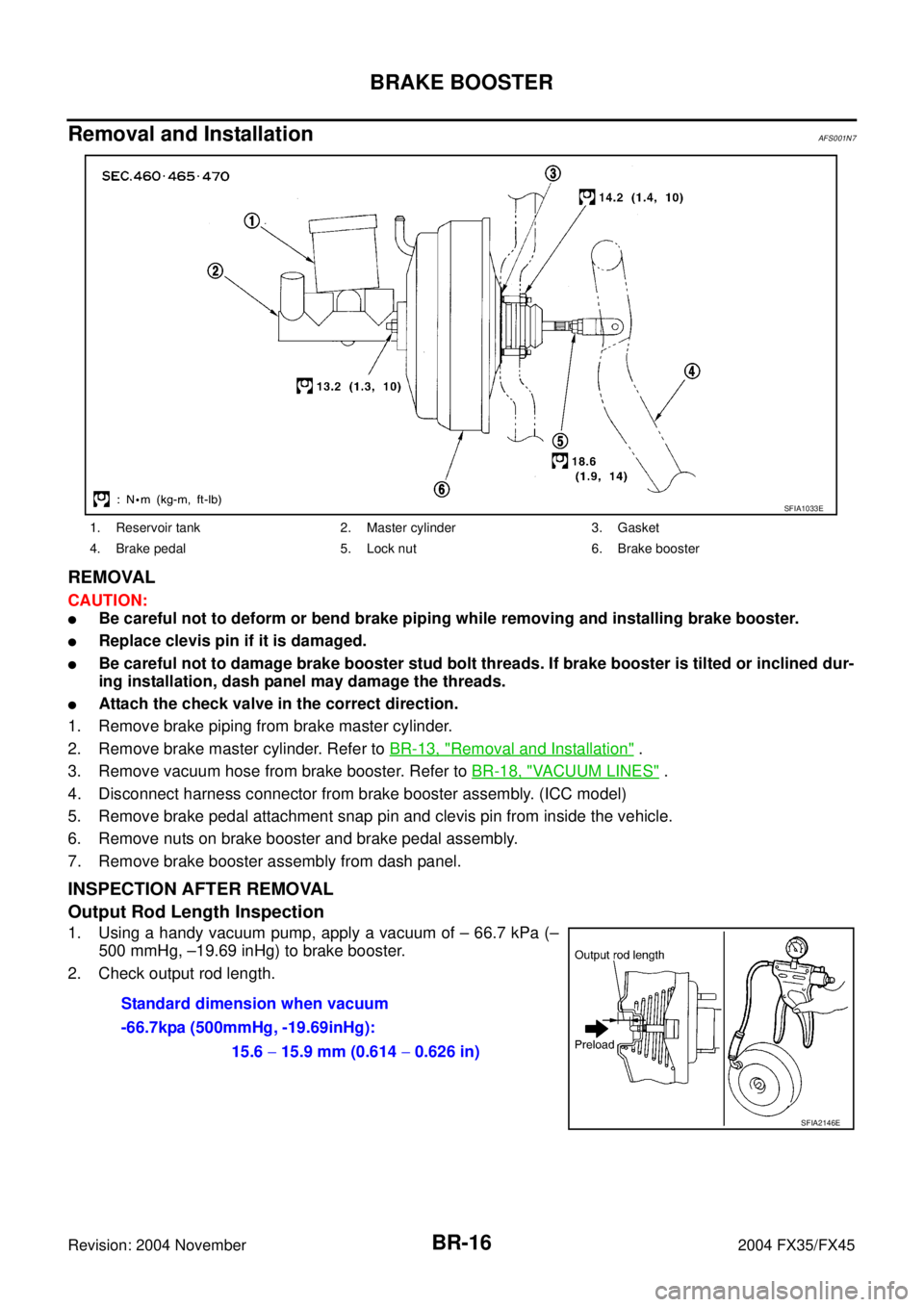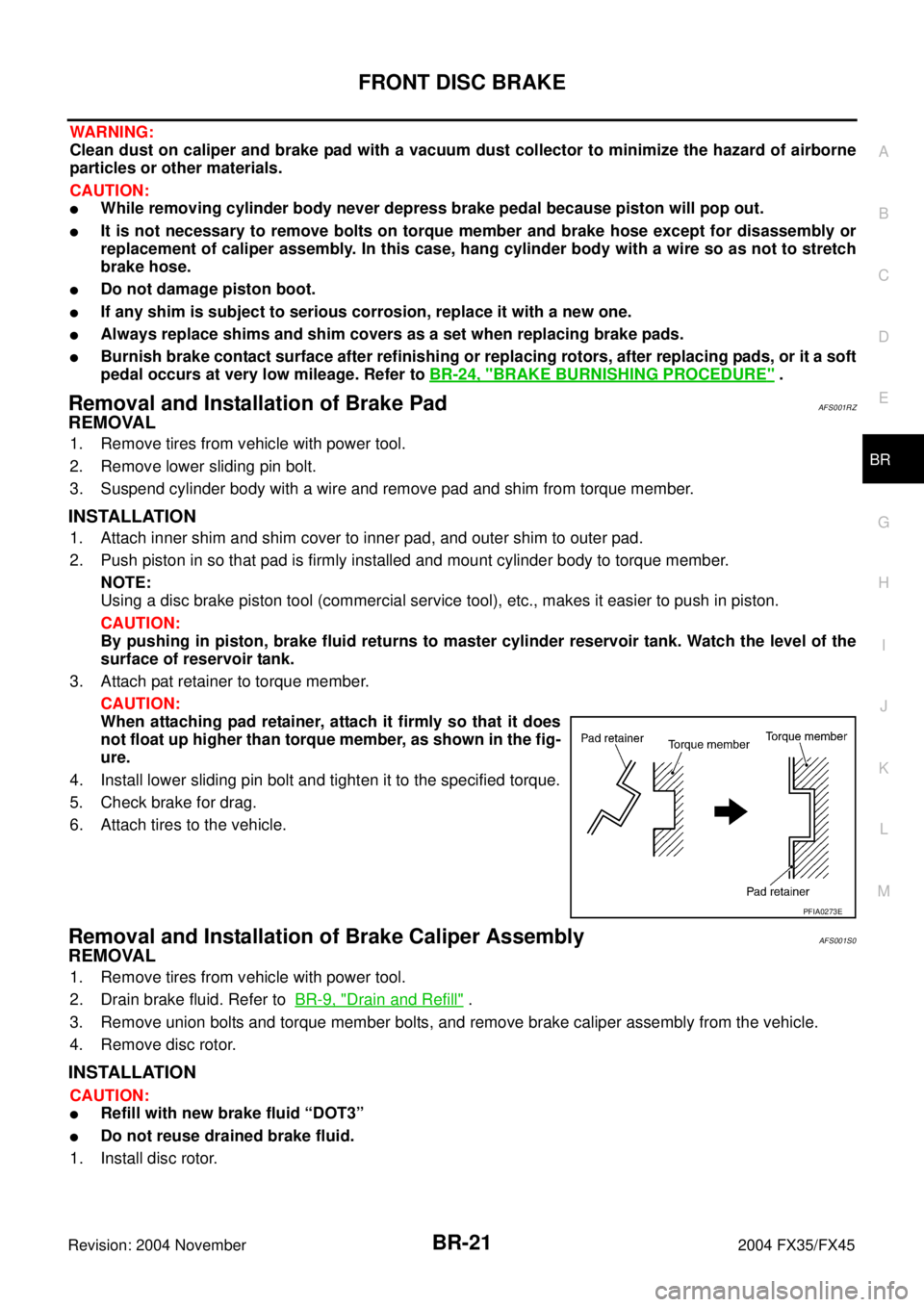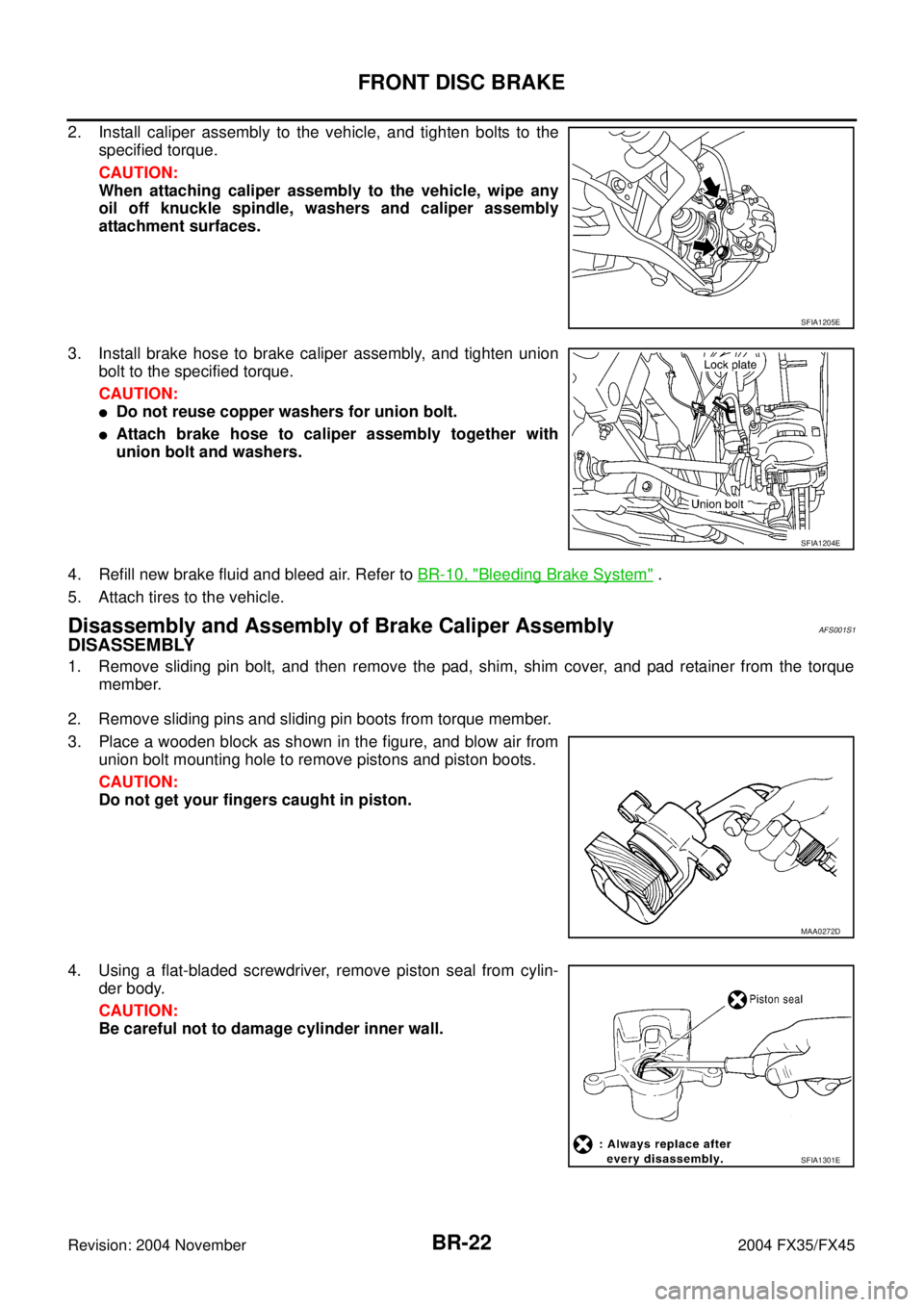Page 1103 of 4449
BR-10
BRAKE FLUID
Revision: 2004 November 2004 FX35/FX45
Bleeding Brake SystemAFS001MX
CAUTION:
While bleeding, pay attention to master cylinder fluid level.
1. Turn ignition switch OFF and disconnect ABS actuator and electric unit (control unit) connector or battery
negative terminal.
2. Connect a vinyl tube to the rear right bleed valve.
3. Fully depress brake pedal 4 to 5 times.
4. With brake pedal depressed, loosen bleed valve to let the air out, and then tighten it immediately.
5. Repeat steps 3, 4 until no more air comes out.
6. Tighten bleed valve to the specified torque. Refer to BR-20, "
Components" (front disc brake), BR-25,
"Components" (rear disc brake).
7. In steps 2 to 6 below, with master cylinder reservoir tank filled at least half way, bleed air from the front left,
rear left, and front right bleed valve, in that order.
Page 1106 of 4449

BRAKE MASTER CYLINDER
BR-13
C
D
E
G
H
I
J
K
L
MA
B
BR
Revision: 2004 November 2004 FX35/FX45
BRAKE MASTER CYLINDERPFP:46010
On-board InspectionAFS001N2
LEAK INSPECTION
�Check for leaking in master cylinder attachment portion, reservoir tank, and brake tube connections.
Removal and InstallationAFS001N3
CAUTION:
Be careful not to splash brake fluid on painted areas; it way cause paint damage. If brake fluid is
splashed on painted areas, wash it away with water immediately.
REMOVAL
1. Drain brake fluid. Refer to BR-9, "Drain and Refill" .
2. Disconnect harness connectors for fluid level sensor and pressure sensor.
3. Using a flare nut wrench, disconnect brake tube from master cylinder assembly.
4. Remove master cylinder assembly fixing nut, remove master cylinder assembly from the vehicle. Refer to
BR-16, "
Removal and Installation" .
INSTALLATION
�Install in the reverse order of removal.
–Refill brake fluid and bleed air. Refer to BR-10, "Bleeding Brake System" .
CAUTION:
�Refill with new brake fluid “DOT3”.
�Do not reuse drained brake fluid.
ComponentsAFS001N4
SFIA2157E
Page 1107 of 4449
BR-14
BRAKE MASTER CYLINDER
Revision: 2004 November 2004 FX35/FX45
Disassembly and AssemblyAFS001N5
DISASSEMBLY
CAUTION:
�Master cylinder can not be disassembly.
�Remove reservoir tank only when absolutely necessary.
1. Remove clip.
2. Remove reservoir tank and grommet from master cylinder
assembly.
ASSEMBLY
CAUTION:
�Never use mineral oil such as kerosene, gasoline during the cleaning and assembly process.
�Do not drop parts. If a part is dropped, do not use it.
1. Apply brake fluid grommet and attach to master cylinder assembly.
CAUTION:
Do not reuse grommet.
2. Install reservoir tank onto master cylinder assembly.
3. Install clip.
1. Reservoir cap 2. Strainer 3. Float
4. Reservoir tank 5. Grommet 6. Master cylinder sub-assembly
7. Clip 8. Pressure sensor 9. Pressure sensor (Only ICC models)
SFIA1132E
SFIA1132E
Page 1109 of 4449

BR-16
BRAKE BOOSTER
Revision: 2004 November 2004 FX35/FX45
Removal and InstallationAFS001N7
REMOVAL
CAUTION:
�Be careful not to deform or bend brake piping while removing and installing brake booster.
�Replace clevis pin if it is damaged.
�Be careful not to damage brake booster stud bolt threads. If brake booster is tilted or inclined dur-
ing installation, dash panel may damage the threads.
�Attach the check valve in the correct direction.
1. Remove brake piping from brake master cylinder.
2. Remove brake master cylinder. Refer to BR-13, "
Removal and Installation" .
3. Remove vacuum hose from brake booster. Refer to BR-18, "
VACUUM LINES" .
4. Disconnect harness connector from brake booster assembly. (ICC model)
5. Remove brake pedal attachment snap pin and clevis pin from inside the vehicle.
6. Remove nuts on brake booster and brake pedal assembly.
7. Remove brake booster assembly from dash panel.
INSPECTION AFTER REMOVAL
Output Rod Length Inspection
1. Using a handy vacuum pump, apply a vacuum of – 66.7 kPa (–
500 mmHg, –19.69 inHg) to brake booster.
2. Check output rod length.
1. Reservoir tank 2. Master cylinder 3. Gasket
4. Brake pedal 5. Lock nut 6. Brake booster
SFIA1033E
Standard dimension when vacuum
-66.7kpa (500mmHg, -19.69inHg):
15.6 − 15.9 mm (0.614 − 0.626 in)
SFIA2146E
Page 1110 of 4449
BRAKE BOOSTER
BR-17
C
D
E
G
H
I
J
K
L
MA
B
BR
Revision: 2004 November 2004 FX35/FX45
INSTALLATION
1. Loosen lock nut to adjust input rod length so that the length B (in
the figure) satisfies the specified value.
2. After adjusting “B”, temporarily tighten lock nut to install booster
assembly to the vehicle. At this time, make sure to install a gas-
ket between booster assembly and the dash panel.
3. Connect brake pedal with clevis of input rod.
4. Install pedal bracket mounting nuts and tighten them to the
specified torque.
5. Install brake piping from brake master cylinder to ABS actuator.
Refer to BR-11, "
Hydraulic Circuit" .
6. Install master cylinder to booster assembly. Refer to BR-16, "
Removal and Installation" .
7. Adjust the height and play of brake pedal.
8. Tighten lock nut of input rod to the specified torque.
9. Refill new brake fluid and bleed air. Refer to BR-10, "
Bleeding Brake System" . Length “B” : 125 mm (4.92 in)
SGIA0060E
Page 1113 of 4449
BR-20
FRONT DISC BRAKE
Revision: 2004 November 2004 FX35/FX45
FRONT DISC BRAKEPFP:41000
On-vehicle InspectionAFS001RX
PAD WEAR INSPECTION
�Inspect the thickness of pad through cylinder body inspection
hole. Use a scale for inspection if necessary.
ComponentsAFS001RY
Standard thickness : 9.5 mm (0.374 in)
Repair limit thickness : 2.0 mm (0.079 in)
BRA0010D
1. Union bolt 2. Copper washer 3. Brake hose
4. Sliding pin bolt 5. Sliding pin 6. Cap
7. Bleed valve 8. Cylinder body 9. Sliding pin boot
10. Piston seal 11. Piston 12. Piston boot
13. Torque member 14. Inner shim cover 15. Inner shim
16. Inner pad 17. Pad retainer (Upper) 18. Pad retainer (Lower)
19. Outer pad 20. Outer shim 21. Torque member bolt
SFIA2378E
Page 1114 of 4449

FRONT DISC BRAKE
BR-21
C
D
E
G
H
I
J
K
L
MA
B
BR
Revision: 2004 November 2004 FX35/FX45
WARNING:
Clean dust on caliper and brake pad with a vacuum dust collector to minimize the hazard of airborne
particles or other materials.
CAUTION:
�While removing cylinder body never depress brake pedal because piston will pop out.
�It is not necessary to remove bolts on torque member and brake hose except for disassembly or
replacement of caliper assembly. In this case, hang cylinder body with a wire so as not to stretch
brake hose.
�Do not damage piston boot.
�If any shim is subject to serious corrosion, replace it with a new one.
�Always replace shims and shim covers as a set when replacing brake pads.
�Burnish brake contact surface after refinishing or replacing rotors, after replacing pads, or it a soft
pedal occurs at very low mileage. Refer to BR-24, "
BRAKE BURNISHING PROCEDURE" .
Removal and Installation of Brake PadAFS001RZ
REMOVAL
1. Remove tires from vehicle with power tool.
2. Remove lower sliding pin bolt.
3. Suspend cylinder body with a wire and remove pad and shim from torque member.
INSTALLATION
1. Attach inner shim and shim cover to inner pad, and outer shim to outer pad.
2. Push piston in so that pad is firmly installed and mount cylinder body to torque member.
NOTE:
Using a disc brake piston tool (commercial service tool), etc., makes it easier to push in piston.
CAUTION:
By pushing in piston, brake fluid returns to master cylinder reservoir tank. Watch the level of the
surface of reservoir tank.
3. Attach pat retainer to torque member.
CAUTION:
When attaching pad retainer, attach it firmly so that it does
not float up higher than torque member, as shown in the fig-
ure.
4. Install lower sliding pin bolt and tighten it to the specified torque.
5. Check brake for drag.
6. Attach tires to the vehicle.
Removal and Installation of Brake Caliper AssemblyAFS001S0
REMOVAL
1. Remove tires from vehicle with power tool.
2. Drain brake fluid. Refer to BR-9, "
Drain and Refill" .
3. Remove union bolts and torque member bolts, and remove brake caliper assembly from the vehicle.
4. Remove disc rotor.
INSTALLATION
CAUTION:
�Refill with new brake fluid “DOT3”
�Do not reuse drained brake fluid.
1. Install disc rotor.
PFIA0273E
Page 1115 of 4449

BR-22
FRONT DISC BRAKE
Revision: 2004 November 2004 FX35/FX45
2. Install caliper assembly to the vehicle, and tighten bolts to the
specified torque.
CAUTION:
When attaching caliper assembly to the vehicle, wipe any
oil off knuckle spindle, washers and caliper assembly
attachment surfaces.
3. Install brake hose to brake caliper assembly, and tighten union
bolt to the specified torque.
CAUTION:
�Do not reuse copper washers for union bolt.
�Attach brake hose to caliper assembly together with
union bolt and washers.
4. Refill new brake fluid and bleed air. Refer to BR-10, "
Bleeding Brake System" .
5. Attach tires to the vehicle.
Disassembly and Assembly of Brake Caliper AssemblyAFS001S1
DISASSEMBLY
1. Remove sliding pin bolt, and then remove the pad, shim, shim cover, and pad retainer from the torque
member.
2. Remove sliding pins and sliding pin boots from torque member.
3. Place a wooden block as shown in the figure, and blow air from
union bolt mounting hole to remove pistons and piston boots.
CAUTION:
Do not get your fingers caught in piston.
4. Using a flat-bladed screwdriver, remove piston seal from cylin-
der body.
CAUTION:
Be careful not to damage cylinder inner wall.
SFIA1205E
SFIA1204E
MAA0272D
SFIA1301E